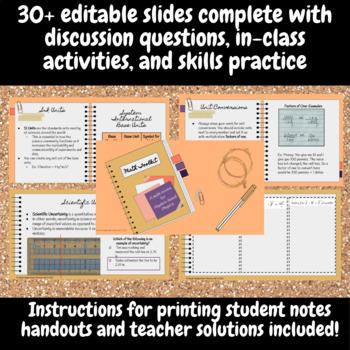Math Toolkit: A Math Review and Lab Measurement Practice - Physics Unit Bundle
- Zip
Description
What is the Math Toolkit and Why do I need to include this unit in my physics or physical science course?
The Math toolkit Unit is designed to help your physics students review essential content in their math, problem-solving, unit converting, and laboratory practice skills before digging into all that great content. This is a great unit to start the year out with to ensure your students have all the prerequisite knowledge they need to be successful in the class.
Teaching and Planning Made Easy
All the planning, content creation, solutions, and assessment building, unit guide design, etc is done for you with this unit. Simply print and teach. I have done all the planning work so that you can focus on being the great teacher you are!
What Content is Covered in this Unit Bundle?
- What is Physics and why do we need to use math? Math as a model.
- SI Units and their importance to the science community and Scientific Method.
- SI Base Units and Prefixes
- Dimensional Analysis and examples
- Standards for Measurement calibration for the 3 base units. STEM connection to history.
- Scientific Notation and Examples.
- Unit conversion and Examples - Teacher Solutions included
- Algebra Rules of Problem Solving and Examples - Teacher Solutions included
- Measurements in the lab: Parallax, Precision, Accuracy, and Uncertainty
What other products do you have that pair well with this one?
- Looking for a great getting to know you, first-day activity to get students engaged, talking to each other, and learning about their classroom environment? Visit my TPT store and check out the Engineering Design Day.
- Love the Bellringer Journal in this unit? Stay tuned for a Bellringer Journal Bundle, with all the bellringers you will need for your entire course for the year/semester.
What do I get with this Unit Bundle?
For the Math Toolkit Unit Bundle, you will receive over 28+ pages of content, activities, instructions, unit guides, lesson plans, assessments, solutions, and more. As well as 30+ unique slides with engaging content, connections to the real-world problem-solving of physics, mathematics, and the scientific method, in-class discussion questions/activities, and example problems to model these skills for your students.
- An aligned Lesson Plan with Next Generation Science Standards, Common Core State Standards for Mathematics, Cross-Cutting Concepts, and Science and Engineering Practices.
- Experienced Teacher Tips, tricks, and advice.
- Unit planning guide for both 90 minute and 50 minute class periods. This single-page guide gives you an overview of the entire unit day by day along with a checklist of tasks, materials needed, and suggested assignments and due dates. All your planning is done for you!
- Bellringer Journal for Students: A printable Bellringer journal with a warmup/bellringer for each class day of the unit.
- Content aligned to review what the students learned the previous day, prepare them for/engage them with the upcoming lesson for the day, or introduce them to diverse role models in physics.
- Powerpoint presentation with great content, real-world connections to the Big Ideas, example problems, and in-class activities/discussions. Tips, tricks, and advice is included in the speaker notes section for most slides. Create student copies of the notes by printing these in handout mode on PowerPoint. (Instructions for creating skeleton notes and handout copies for your students included)
- Teacher's Solutions guide to the Powerpoint examples with step-by-step solutions.
- Student Practice Packet with problems reflecting the content learned in the presentation. Great for homework, in-class practice, or both!
- Teacher's Solutions to Student Practice Packet with step-by-step solutions for all problems and written answers for all open-ended discussion questions.
- Unit Assessment for students aligned to NGSS and unit objectives.
- Teacher's Solutions to the Unit Assessment for quick and easy grading.
- Assistance from me at any time!
Thank You and Contact Me:
Thank you so much for your support! I hope this unit brings as much joy, stability, and fun into your classroom as it has to my own. Please feel free to contact me at physicswithmsg@gmail.com at any time with questions or any issues with the materials. Thank you and Happy Planning!
Note:
This resource covers the same content as my Math Toolkit Doodle Notes Resources. However, it does not align with those resources.





